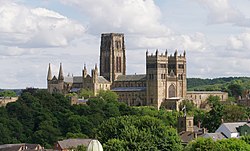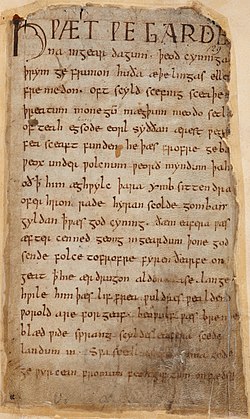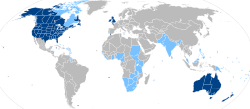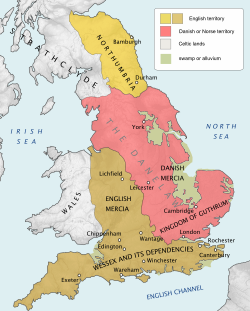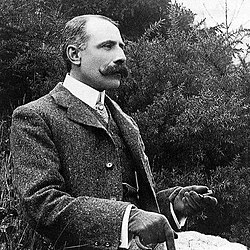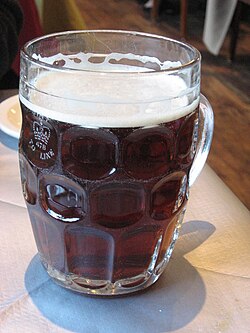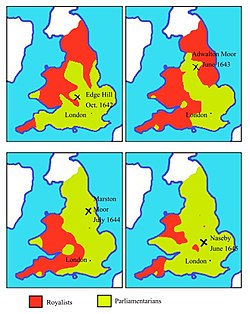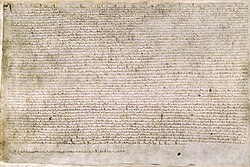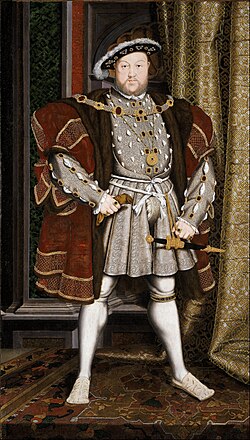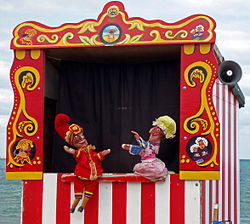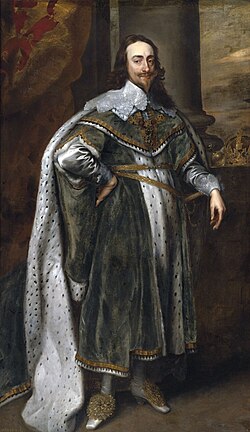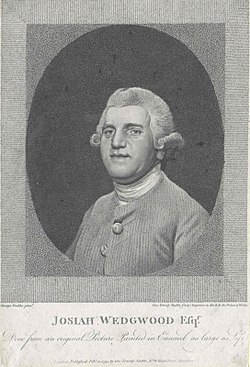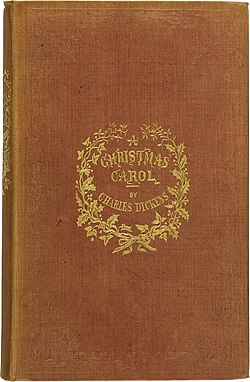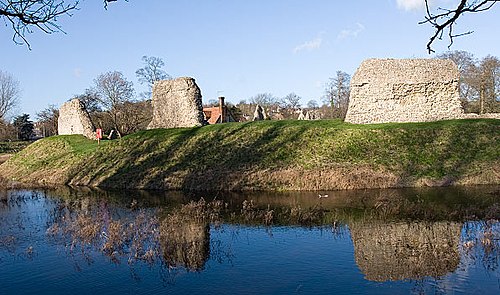The England portal

| |
England is a country that is part of the United Kingdom. It is located on the island of Great Britain, of which it covers about 62%, and more than 100 smaller adjacent islands. England shares a land border with Scotland to the north and another land border with Wales to the west, and is otherwise surrounded by the North Sea to the east, the English Channel to the south, the Celtic Sea to the south-west, and the Irish Sea to the west. Continental Europe lies to the south-east, and Ireland to the west. At the 2021 census, the population was 56,490,048. London is both the largest city and the capital.
The area now called England was first inhabited by modern humans during the Upper Paleolithic. It takes its name from the Angles, a Germanic tribe who settled during the 5th and 6th centuries. England became a unified state in the 10th century and has had extensive cultural and legal impact on the wider world since the Age of Discovery, which began during the 15th century. The Kingdom of England, which included Wales after 1535, ceased to be a separate sovereign state on 1 May 1707, when the Acts of Union brought into effect a political union with the Kingdom of Scotland that created the Kingdom of Great Britain.
England is the origin of the English language, the English legal system (which served as the basis for the common law systems of many other countries), association football, and the Anglican branch of Christianity; its parliamentary system of government has been widely adopted by other nations. The Industrial Revolution began in 18th-century England, transforming its society into the world's first industrialised nation. England is home to the two oldest universities in the English-speaking world: the University of Oxford, founded in 1096, and the University of Cambridge, founded in 1209. Both universities are ranked amongst the most prestigious in the world.
England's terrain chiefly consists of low hills and plains, especially in the centre and south. Upland and mountainous terrain is mostly found in the north and west, including Dartmoor, the Lake District, the Pennines, and the Shropshire Hills. The London metropolitan area has a population of 14.2 million as of 2021, representing the United Kingdom's largest metropolitan area. England's population of 56.3 million comprises 84% of the population of the United Kingdom, largely concentrated around London, the South East, and conurbations in the Midlands, the North West, the North East, and Yorkshire, which each developed as major industrial regions during the 19th century. (Full article...)
The Chew Valley is an affluent area in North Somerset, England, named after the River Chew, which rises at Chewton Mendip, and joins the River Avon at Keynsham. Technically, the area of the valley is bounded by the water catchment area of the Chew and its tributaries; however, the name Chew Valley is often used less formally to cover other nearby areas, for example, Blagdon Lake and its environs, which by a stricter definition are part of the Yeo Valley. The valley is an area of rich arable and dairy farmland, interspersed with a number of villages.
The landscape consists of the valley of the River Chew and is generally low-lying and undulating. It is bounded by higher ground ranging from Dundry Down and the south western boundary of Keynsham town to the north, the Lulsgate Plateau to the west, the Mendip Hills to the south and the Hinton Blewett, Temple Cloud, Clutton and Marksbury plateau areas to the east. The valley's boundary generally follows the top of scarp slopes except at the southwestern and southeastern boundaries where flat upper areas of the Chew Valley grade gently into the Yeo Valley and eastern Mendip Hills respectively. The River Chew was dammed in the 1950s to create Chew Valley Lake, which provides drinking water for the nearby city of Bristol and surrounding areas. The lake is a prominent landscape feature of the valley, a focus for recreation, and is internationally recognised for its nature conservation interest, because of the bird species, plants and insects. (Full article...)
Selected article -
Wembley Stadium, currently branded as Wembley Stadium connected by EE for sponsorship reasons, is an association football stadium in Wembley, London, England. It opened in 2007 on the site of the original Wembley Stadium, which had stood from 1923 until 2003. The stadium is England's national football stadium, and thus hosts the majority of the England national team home matches and the FA Cup Final – the final of England's primary domestic club football competition. It is considered one of the most well known football stadiums in the world, and is considered a hub for the English game. Wembley Stadium is owned by the governing body of English football, the Football Association, whose headquarters are in the stadium, through its subsidiary Wembley National Stadium Ltd (WNSL). With 90,000 seats, it is the largest stadium in the UK and the second-largest stadium in Europe, behind Barcelona's Camp Nou.
Designed by Populous and Foster and Partners, the stadium is crowned by the 134-metre-high (440 ft) Wembley Arch which serves aesthetically as a landmark across London as well as structurally, with the arch supporting over 75% of the entire roof load. The stadium was built by Australian firm Multiplex at a cost of £798 million (£1.51 billion today). Two partially retractable roof structures over the east and west ends of the stadium can be opened to allow sunlight and aid pitch growth. (Full article...)
General images
Berkhamsted Castle is a Norman motte-and-bailey castle in Berkhamsted, Hertfordshire. The castle was built to obtain control of a key route between London and the Midlands during the Norman conquest of England in the 11th century. Robert of Mortain, William the Conqueror's half brother, was probably responsible for managing its construction, after which he became the castle's owner. The castle was surrounded by protective earthworks and a deer park for hunting. The castle became a new administrative centre of the former Anglo-Saxon settlement of Berkhamsted. Subsequent kings granted the castle to their chancellors. The castle was substantially expanded in the mid-12th century, probably by Thomas Becket.
The castle was besieged in 1216 during the civil war between King John and rebellious barons, who were supported by France. It was captured by Prince Louis, the future Louis VIII, who attacked it with siege engines for twenty days, forcing the garrison to surrender. After being retaken by royal forces the subsequent year, it was given to Richard, Earl of Cornwall, beginning a long association with the Earldom of Cornwall and the later duchy. Richard redeveloped the castle as a palatial residence, and made it the centre of the earldom's administration. King Edward III further developed the castle in the 14th century and gave it to his son, Edward, the Black Prince, who expanded the hunting grounds. The castle was also used to hold royal prisoners, including King John II of France and rival claimants to the English throne. (Full article...)
Did you know?
- ...that Lambeth, in the London Borough of Lambeth appeared in the Domesday Book of 1086?
- ...that Kate Marsden journeyed overland to Siberia to find a leprosy cure.
- ...that the Old Bailey was destroyed in the 1666 Great Fire of London, only to be rebuilt in 1674?
- ...that a Jury is only sent to cases of an indictable offence that has been sent to a Crown Court by a magistrates?
In the news

- 3 October 2025 –
- Bishop of London Sarah Mullally is announced as the new Archbishop of Canterbury, becoming the first woman to lead the Church of England and the Anglican Communion. (BBC News)
- 2 October 2025 – Terrorism in the United Kingdom
- Two people are killed and four others are injured in a vehicle-ramming and mass stabbing attack at the Heaton Park Hebrew Congregation synagogue in Crumpsall, Manchester, England, United Kingdom. The perpetrator and one of the victims are shot dead by police. The attack is later declared a terror attack. (CNN) (The New York Times) (Reuters)
- 27 September 2025 – 2025 Women's Rugby World Cup
- England defeats Canada in the final of the 2025 Women's Rugby World Cup. (BBC News)
- 23 September 2025 – 2025 British anti-immigration protests
- An English magistrates' court sentences an Ethiopian asylum-seeker to 12 months in prison for sexually assaulting a woman and a 14-year-old girl, an incident that triggered nationwide protests over migration policies and the housing of asylum-seekers in hotels. (AP)
- 15 September 2025 –
- Recorder of London Mark Lucraft sentences English couple Constance Marten and Mark Gordon to 14 years in prison each for the manslaughter of their newborn daughter. (CBS News)
- 13 September 2025 – 2025 British anti-immigration protests
- More than 100,000 people protest against illegal immigration in central London, England, in a rally led by right-wing activist Tommy Robinson. Thousands of anti-racism protesters and left-wing groups also hold counter-protests. (BBC News)
Selected featured content
Categories
Selected quotes
| “ | I have seen much to hate here, much to forgive. But in a world where England is finished and dead, I do not wish to live. | ” |
Related WikiProjects
England • Bedfordshire • Brighton • Cheshire • Cornwall • Derbyshire • Dorset • Greater Manchester • Hampshire • Lincolnshire • London • Merseyside • Northamptonshire • North East England • Sheffield • Surrey. Warwickshire • West Midlands • Worcestershire • Yorkshire
Topics
Things you can do

- Please visit the English Wikipedians' notice board and help to write new England-related articles, and expand and improve existing ones.
- Visit Wikipedia:WikiProject England/Assessment, and help out by assessing unrated English articles.
- Add the Project Banner to English articles around Wikipedia.
- Check for announcements and open tasks for ways to improve English related articles.
- Help nominate and select new content for the England portal.
- Requested articles: Charterhouse Lane • Renewable energy in England • Ealing Village
- Expand: Dorothy Boyd • David Troughton
Related Portals
 |
 |
 |
 |
 |
 |
 |
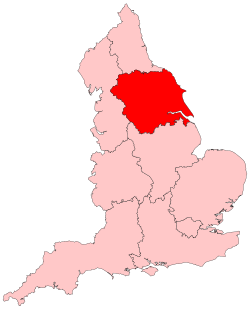 |
| East Midlands | London | North East | North West | South East | South West | West Midlands | Yorkshire and the Humber |

|

|

|

|

|
| Ireland | Northern Ireland | Scotland | United Kingdom | Wales |
Associated Wikimedia
The following Wikimedia Foundation sister projects provide more on this subject:
-
Commons
Free media repository -
Wikibooks
Free textbooks and manuals -
Wikidata
Free knowledge base -
Wikinews
Free-content news -
Wikiquote
Collection of quotations -
Wikisource
Free-content library -
Wikiversity
Free learning tools -
Wikivoyage
Free travel guide -
Wiktionary
Dictionary and thesaurus
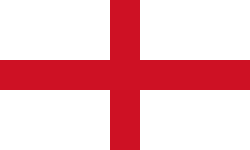
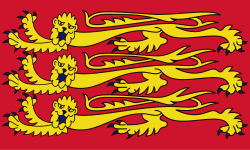





![Image 5The Staffordshire Hoard is the largest hoard of Anglo-Saxon gold and silver metalwork yet found[update]. It consists of almost 4,600 items and metal fragments. (from Culture of England)](https://upload.wikimedia.org/wikipedia/commons/thumb/6/60/Staffordshire_hoard_annotated.jpg/250px-Staffordshire_hoard_annotated.jpg)
